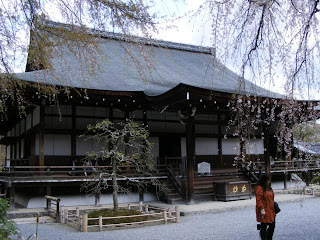In the middle of Arashiyama, Tehryu-ji is a temple with a
UNESCO protected garden, much visited by the tourists who come here. This is
the head temple of the Rinzai Budhist sect, a Zen temple. It was founded by the
shogun Ashikaga Takauji, in 1339, to homour the emperor Go-Daigo. As with most
of the temples, this one was also destroyed by fire and then reconstructed
during the Meiji era. Initially, in 834-848, a big convent named Danrin-ji had
its place here. During the Heian era it was ruined, and a retired emperor constructed here a palace.
This was inherited by the emperor Kameyama, and then his nephew, Go-Daigo. In
order to fulfil the proposal of the priest Muso Soseki to built here a temple,
Go-Daigo developed the trade with China, using the taxes to construct the
temple.
I would say that this perseverance of the Japanese people
to rebuilt again and again what was destroyed, keeping thus the continuity of
their religion, history and culture, was the characteristics which imopressed
me the most in Japan!
From the terrace of the building O-Hojo one could admire
the shakkei garden ( a garden with borrowed landscape) built by the priest Muso
Soseki – who was also a highly skilled gardener – around the Sogen-chi pond. In
O-Hojo it is the portrait of the Indian Budhist monk Daruma, the founder of Zen.
He exported Zen in China afterwards.
Aflat in mijlocul cartierului Arashiyama, templul Tenryu cu o gradina aflata sub protectie UNESCO, este unul din cele mai importante obiective ale turistilor care viziteaza zona aceasta nu doar pitoreasca, ci si plina de temple. Acesta este templul principal al sectei budhiste Rinzai, un templu Zen. El a fost fondat de catre shogunul Ashikaga Takauji, in 1339, in cinstea imparatului vremii, Godaigo. Asa cum s-a intamplat cu mai toate templele si acesta a fost distrus de un incendiu dar a fost reconstruit incepand cu perioada Meiji.
Initial, in anii 834-848, existase aici o manastire mare, numita Danrin-ji, care – in perioada Heian – a ajuns in ruina. Pe locul gol, un imparat aflat in retragere de la domnie a construit un palat numit Kameyama-dono, mostenit de imparatul Kameyama si apoi de nepotul sau. Go-Daigo. Pentru a implini propunerea preotului Muso Soseki de a construi aici un templu, Go-Daigo a dezvoltat comertul cu China si a folosit taxele pentru finantarea constructiei.
As spune ca aceasta indarjire a japonezilor de a reface mereu si mereu ce a fost distrus, pastrand astfel o continuitate a religiei, istoriei si culturii lor, este ceea ce m-a impresionat cel mai mult in Japonia.
In jurul iazului Sogen-chi, o gradina pentru
plimbare, proiectata si executata de catre preotul Muso Soseki – primul preot
sef al templului, in stilul shakkei (cu peisaj imprumutat, cel al
muntilor Arashiyama si Kameyama), este admirata de pe terasa cladirii O-Hojo.
In O-Hojo se afla portretul calugarului budhist indian Daruma, care este fondatorul Zen Budhismului. El este cel care l-a exportat apoi in China.
Trecand printr-un pasaj acoperit, Kairo, am ajuns
intr-o zona predominata de ciresi-plangatori. Kairo leaga O-Hojo de Taho-den. In iarba, cativa muncitori,
smulgeau cu mana fiecare buruiana. In aceasta zona, aflata aproape de o iesire
secundara, gravitau multi turisti care se fotografiau sub ciresi.
spre templu
Maria Kannon
una dintre intrarile in gradina
intrarea principala in templu
calugarul budhist indian, Daruma, fondatorul Zen Budhismului
asa sunt ingrijite toate gradinile!
camelii


























8 comments:
So wonderful with these lovely blossom..... good serie as always.
greetings, Joop
Thanks, Joop! Have a good day.
So wonderful.
Thanks, Randy, for visiting so constantly.
I see some really beautiful flowers and other things but those waters and ponds I really fantastic! Really enjoying this.
Greetings, Helma
Thank you, Helma! Have you been in Japan?
no, unfortunately not. I know only from movies and Japan doumantaires
May be, some day...
Post a Comment